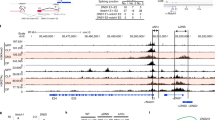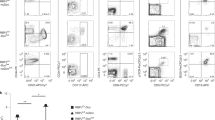Abstract
Notch receptors and their ligands contribute to many developmental systems, but it is not apparent how they function after birth, as their null mutants develop severe defects during embryogenesis. Here we used the Cre-loxP system to delete the Delta-like 1 gene (Dll1) after birth and demonstrated the complete disappearance of splenic marginal zone B cells in Dll1-null mice. In contrast, T cell development was unaffected. These results demonstrated that Dll1 was dispensable as a ligand for Notch1 at the branch point of T cell–B cell development but was essential for the generation of marginal zone B cells. Thus, Notch signaling is essential for lymphocyte development in vivo, but there is a redundancy of Notch-Notch ligand signaling that can drive T cell development within the thymus.
This is a preview of subscription content, access via your institution
Access options
Subscribe to this journal
Receive 12 print issues and online access
$209.00 per year
only $17.42 per issue
Buy this article
- Purchase on Springer Link
- Instant access to full article PDF
Prices may be subject to local taxes which are calculated during checkout





Similar content being viewed by others
References
Simpson, P. The Notch connection. Nature 375, 736–737 (1995).
Lewis, J. Notch signaling and the control of cell fate choices in vertebrates. Semin. Cell Dev. Biol. 9, 583–589 (1998).
Robey, E. Notch in vertebrates. Curr. Opin. Genet. Dev. 7, 551–557 (1997).
Radtke, F., Wilson, A., Mancini, S.J.C. & MacDonald, H.R. Notch regulation of lymphocyte development and function. Nat. Immunol. 5, 247–253 (2004).
Radtke, F. et al. Deficient T cell fate specification in mice with an induced inactivation of Notch1. Immunity 10, 547–558 (1999).
Han, H. et al. Inducible gene knockout of transcription factor recombination signal binding protein-J reveals its essential role in T versus B lineage decision. Int. Immunol. 14, 637–645 (2002).
Pui, J.C. et al. Notch1 expression in early lymphopoiesis influences B versus T lineage determination. Immunity 11, 299–308 (1999).
Tanigaki, K. et al. Notch-RBP-J signaling is involved in cell fate determination of marginal zone B cells. Nat. Immunol. 3, 443–450 (2002).
Saito, T. et al. Notch2 is preferentially expressed in mature B cells and indispensable for marginal zone B lineage development. Immunity 18, 675–685 (2003).
Kuroda, K. et al. Regulation of marginal zone B cell development by MINT, a suppressor of Notch/RBP-J signaling pathway. Immunity 18, 301–312 (2003).
Bettenhausen, B. Hrabe de Angelis, M., Simon, D., Guénet, J. & Gossler, A. Transient and restricted expression during mouse embryogenesis of Dll-1, a murine gene closely related to Drosophila Delta. Development 121, 2407–2418 (1995).
Jaleco, A.C. et al. Differential effects of Notch ligands Delta-1 and Jagged-1 in human lymphoid differentiation. J. Exp. Med. 194, 991–1001 (2001).
Schmitt, T.M. & Zúñiga-Pflücker, J.C. Induction of T cell development from hematopoietic progenitor cells by Delta-like-1 in vitro. Immunity 17, 749–756 (2002).
Hrabe de Angelis, M., McIntyre II, J. & Gossler, A. Maintenance of somite borders in mice requires the Delta homologue Dll1. Nature 386, 717–721 (1997).
Tax, F.E., Yeargers, J.J. & Thomas, J.H. Sequence of C. elegans lag-2 reveals a cell-signalling domain shared with Delta and Serrate of Drosophila. Nature 368, 150–154 (1994).
Shimizu, K. et al. Mouse Jagged1 physically interacts with Notch2 and other Notch receptors. J. Biol. Chem. 274, 32961–32969 (1999).
Kühn, R., Schwenk, F., Aguet, M. & Rajewsky, K. Inducible gene targeting in mice. Science 269, 1427–1429 (1995).
Martin, F. & Kearney, J.F. Marginal-zone B cells. Nat. Rev. Immunol. 2, 323–335 (2002).
Roark, J.H. et al. CD1.1 expression by mouse antigen-presenting cells and marginal zone B cells. J. Immunol. 160, 3121–3127 (1998).
Won, W.J. & Kearney, J.F. CD9 is a unique marker for marginal zone B cells, B1 cells, and plasma cells in mice. J. Immunol. 168, 5605–5611 (2002).
Tarutani, M. et al. Tissue-specific knockout of the mouse Pig-a gene reveals important roles for GPI-anchored proteins in skin development. Proc. Natl. Acad. Sci. USA 94, 7400–7405 (1997).
Sano, S. et al. Stat3 in thymic epithelial cells is essential for postnatal maintenance of thymic architecture and thymocyte survival. Immunity 15, 261–273 (2001).
Schutter, J.R. et al. Dll4, a novel Notch ligand expressed in arterial endothelium. Genes Dev. 14, 1313–1318 (2000).
Mailhos, C. et al. Delta4, an endothelial specific Notch ligand expressed at sites of physiological and tumor angiogenesis. Differentiation 69, 135–144 (2001).
Kodama, H., Nose, M., Niida, S., Nishikawa, S. & Nishikawa, S. Involvement of the c-kit receptor in the adhesion of hematopoietic stem cells to stromal cells. Exp. Hematol. 22, 979–984 (1994).
Nishikawa, S. et al. In vitro generation of lymphohematopoietic cells from endothelial cells purified from murine embryos. Immunity 8, 761–769 (1998).
Schmitt, T.M. et al. Induction of T cell development and establishment of T cell competence from embryonic stem cells differentiated in vitro. Nat. Immunol. 5, 410–417 (2004).
Hozumi, K., Abe, N., Chiba, S., Hirai, H. & Habu, S. Active form of Notch members can enforce T lymphopoiesis on lymphoid progenitors in the monolayer culture specific for B cell development. J. Immunol. 170, 4973–4979 (2003).
Yan, X. et al. A novel Notch ligand, Dll4, induces T-cell leukemia/lymphoma when overexpressed in mice by retroviral-mediated gene transfer. Blood 13, 3793–3799 (2001).
Shimizu, K. et al. Integrity of intracellular domain of Notch ligand is indispensable for cleavage required for release of the Notch2 intracellular domain. EMBO J. 21, 294–302 (2002).
Dunwoodie, S.L., Henrique, D., Harrison, S.M. & Beddington, R.S.P. Mouse Dll3: a novel divergent Delta gene which may complement the function of other Delta homologues during early pattern formation in the mouse embryo. Development 124, 3065–3076 (1997).
Felli, M.P. et al. Expression pattern of Notch1, 2 and 3 and Jagged1 and 2 in lymphoid and stromal thymus components: distinct ligand-receptor interactions in intrathymic T cell development. Int. Immunol. 11, 1017–1025 (1999).
Kaneta, M. et al. A role for Pref-1 and HES-1 in thymocyte development. J. Immunol. 164, 256–264 (2000).
Dammers, P.M., de Boer, N.K., Deenen, G.J., Nieuwenhuis, P. & Kroese, F.G. The origin of marginal zone B cells in the rat. Eur. J. Immunol. 29, 1522–1531 (1999).
Cariappa, A. et al. The follicular versus marginal zone B lymphocyte cell fate decision is regulated by Aiolos, Btk, and CD21. Immunity 14, 603–615 (2001).
Rickert, R.C., Roes, J. & Rajewsky, K. B lymphocyte-specific, Cre-mediated mutagenesis in mice. Nucleic Acids. Res. 25, 1317–1318 (1997).
Hozumi, K. et al. Pro-T cells in fetal thymus express c-kit and RAG2 but do not rearrange the gene encoding the T cell receptor β chain. Eur. J. Immunol. 24, 1339–1344 (1994).
Hozumi, K., Kobori, A., Sato, T., Nishimura, T. & Habu, S. Transcription and demethylation of TCR β gene initiate prior to the gene rearrangement in c-kit+ thymocytes with CD3 expression: evidence of T cell commitment in the thymus. Int. Immunol. 8, 1473–1481 (1996).
Aifantis, I., Buer, J., von Boehmer, H. & Azogui, O. Essential role of the pre-T cell receptor in allelic exclusion of the T cell receptor β locus. Immunity 7, 601–607 (1997).
Gärtener, F. et al. Immature thymocytes employ distinct signaling pathways for allelic exclusion versus differentiation and expansion. Immunity 10, 537–546 (1999).
Acknowledgements
We thank H.-R. Rodewald (Ulm University, Ulm, Germany) for comments and critical reading of the manuscript; T. Higgins and I. Rosewell for technical assistance; J. Ito for operating the confocal laser microscope; and Y. Okada and S. Ueno for operating the cell sorter. Supported in part by Scientific Research B (S.H.), the Ministry of Education, Culture, Sports, Science and Technology of Japan, Grant-in-Aid for Young Scientists (K.H.) and Naito Memorial Foundation (K.H.).
Author information
Authors and Affiliations
Corresponding author
Ethics declarations
Competing interests
The authors declare no competing financial interests.
Rights and permissions
About this article
Cite this article
Hozumi, K., Negishi, N., Suzuki, D. et al. Delta-like 1 is necessary for the generation of marginal zone B cells but not T cells in vivo. Nat Immunol 5, 638–644 (2004). https://doi.org/10.1038/ni1075
Received:
Accepted:
Published:
Issue Date:
DOI: https://doi.org/10.1038/ni1075
This article is cited by
-
Two distinct Notch signals, Delta-like 4/Notch1 and Jagged-1/Notch2, antagonistically regulate chemical hepatocarcinogenesis in mice
Communications Biology (2022)
-
Activity of the mouse Notch ligand DLL1 is sensitive to C-terminal tagging in vivo
BMC Research Notes (2021)
-
Notch2-mediated plasticity between marginal zone and follicular B cells
Nature Communications (2021)
-
Oscillations of Delta-like1 regulate the balance between differentiation and maintenance of muscle stem cells
Nature Communications (2021)
-
The human spleen as the center of the blood defense system
International Journal of Hematology (2020)



